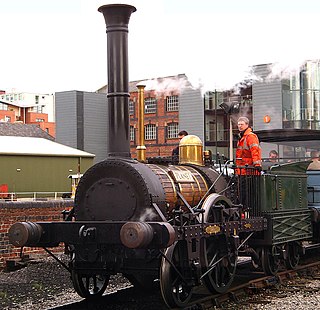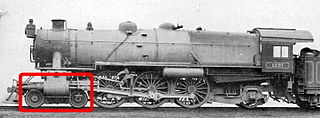Related Research Articles

Whyte notation is a classification method for steam locomotives, and some internal combustion locomotives and electric locomotives, by wheel arrangement. It was devised by Frederick Methvan Whyte, and came into use in the early twentieth century following a December 1900 editorial in American Engineer and Railroad Journal.

Under the Whyte notation for the classification of steam locomotives, 0-4-0 represents one of the simplest possible types, that with two axles and four coupled wheels, all of which are driven. The wheels on the earliest four-coupled locomotives were connected by a single gear wheel, but from 1825 the wheels were usually connected with coupling rods to form a single driven set.
In rail transport, a wheel arrangement or wheel configuration is a system of classifying the way in which wheels are distributed under a locomotive. Several notations exist to describe the wheel assemblies of a locomotive by type, position, and connections, with the adopted notations varying by country. Within a given country, different notations may also be employed for different kinds of locomotives, such as steam, electric, and diesel powered.

Under the Whyte notation for the classification of steam locomotives, 0-6-0 represents the wheel arrangement of no leading wheels, six powered and coupled driving wheels on three axles and no trailing wheels. This was the most common wheel arrangement used on both tender and tank locomotives in versions with both inside and outside cylinders.
The UIC classification of locomotive axle arrangements, sometimes known as the German classification or German system, describes the wheel arrangement of locomotives, multiple units and trams. It is used in much of the world, notable exceptions being the United Kingdom, which uses a slightly simplified form of UIC, and in North America, where the AAR wheel arrangement system is used to describe diesel and electric locomotives; Whyte notation is used in North America only for steam locomotives.

Under Whyte notation for the classification of steam locomotives, 2-2-0 represents the wheel arrangement of two leading wheels on one axle, two powered driving wheels on one axle, and no trailing wheels. This configuration, which became very popular during the 1830s, was commonly called the Planet type after the first locomotive, Robert Stephenson's Planet of 1830.

Under the Whyte notation for the classification of steam locomotives, 4-2-2 represents the wheel arrangement of four leading wheels on two axles, two powered driving wheels on one axle, and two trailing wheels on one axle.

Under the Whyte notation for the classification of steam locomotives, a 2-6-4 locomotive has two leading wheels, six coupled driving wheels and four trailing wheels. This arrangement is commonly called Adriatic.
Under the Whyte notation for the classification of steam locomotives, 0-8-2 represents the wheel arrangement of no leading wheels, eight powered and coupled driving wheels on four axles, and two trailing wheels on one axle.

Under the Whyte notation for the classification of steam locomotives, 2-4-0 represents the wheel arrangement of two leading wheels on one axle, four powered and coupled driving wheels on two axles and no trailing wheels.

Under the Whyte notation for the classification of steam locomotives, 0-4-4 represents the wheel arrangement of no leading wheels, four powered and coupled driving wheels on two axles, and four trailing wheels on two axles. This type was only used for tank locomotives.

Co-Co is the wheel arrangement for diesel or electric locomotives with two six-wheeled bogies with all axles powered, with a separate traction motor per axle. The equivalent UIC classification (Europe) for this arrangement is Co′Co′, or C-C for AAR.
Under the Whyte notation for the classification of steam locomotives, 0-2-4 represents the wheel arrangement of no leading wheels, two powered driving wheels on one axle, and four trailing wheels on two axles.

Under the Whyte notation for the classification of steam locomotives, 0-6-0+0-6-0 represents the wheel arrangement of an articulated locomotive with two separate swivelling engine units, each unit with no leading wheels, six powered and coupled driving wheels on three axles and no trailing wheels. The arrangement is effectively two 0-6-0 locomotives operating back-to-back and was used on Garratt, Double Fairlie, Meyer and Kitson-Meyer articulated locomotives. A similar arrangement exists for Mallet steam locomotives on which only the front engine unit swivels, but these are referred to as 0-6-6-0.
Under the Whyte notation for the classification of steam locomotives, 2-2-2-0 usually represents the wheel arrangement of two leading wheels on one axle, four powered but uncoupled driving wheels on two axles, and no trailing wheels, but can also be used to represent two sets of leading wheels two driving wheels, and no trailing wheels. Some authorities place brackets around the duplicated but uncoupled wheels, creating a notation 2-(2-2)-0, or (2-2)-2-0, as a means of differentiating between them. Others simply refer to the locomotives 2-2-2-0.

The leading wheel or leading axle or pilot wheel of a steam locomotive is an unpowered wheel or axle located in front of the driving wheels. The axle or axles of the leading wheels are normally located on a leading truck. Leading wheels are used to help the locomotive negotiate curves and to support the front portion of the boiler.

Under the Whyte notation for the classification of steam locomotives, 2-2-2-2 could represent either the wheel arrangement of two leading wheels, four powered but uncoupled driving wheels, and two trailing wheels; or of two independent leading axles, two driving wheels, and two trailing wheels.
Under the Whyte notation for the classification of steam locomotives, 2-2-4-0T represents the wheel arrangement of two leading wheels on one axle, two driving wheels powered from the inside cylinders, four coupled driving wheels powered from the outside cylinders but no trailing wheels.
Under the Whyte notation for the classification of steam locomotives, 4-2-2-0 represents the wheel arrangement of four leading wheels on two axles, four powered but uncoupled driving wheels on two axles, and no trailing wheels. The arrangement became known as double single.

The Z21 class was a class of steam locomotives built for the New South Wales Government Railways in Australia.
References
- ↑ "American Steam Locomotive Wheel Arrangements" . Retrieved 13 March 2016.
- 1 2 Baxter 1984, p. 139.
- Baxter, Bertram (1984). British locomotive catalogue 1825-1923. Vol. 4. Buxton: Moorland Publishing.